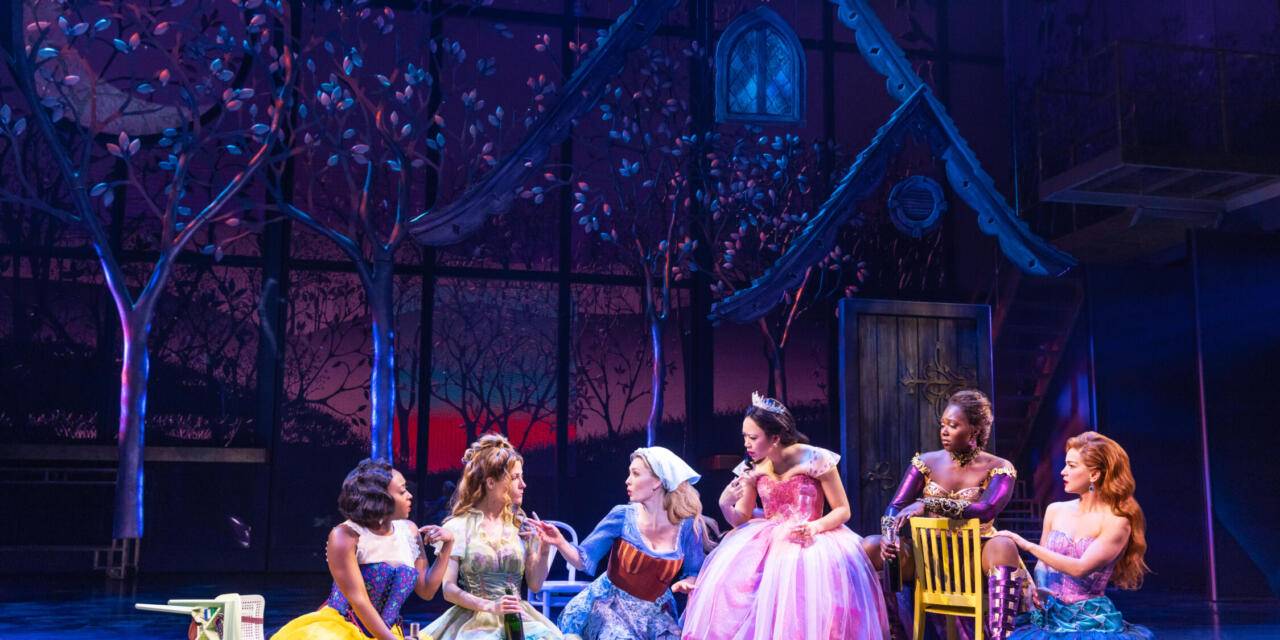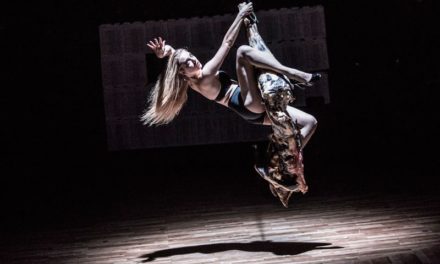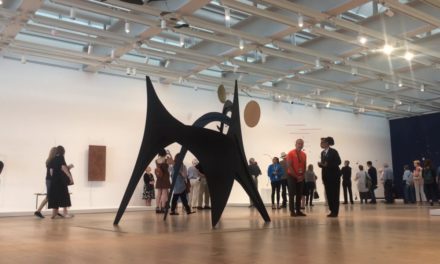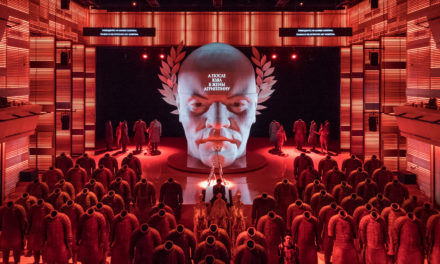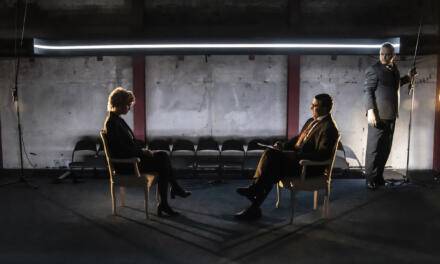“We’re not here to make fairytales, we’re here to follow them,” quips the narrator (Adam Godley) early on in Once Upon a One More Time, the Britney Spears jukebox musical playing at the Marquis Theater. Although he is the show’s antagonist, his pronouncement is unfortunately apt. Once Upon a One More Time is an insipid regurgitation of fairytales and their nominally feminist retellings with little new to offer. But for such a transparent cash grab has it actually, well, grabbed the cash? The $20 million show is closing on September 3rd after 123 performances leaving me wondering when will the mainstream theater industry take the risks needed to put forth theater that audiences are actually interested in?
The story takes place inside a book of fairytales where a gaggle of princesses discovers feminism and rebels against their tyrannical narrator. It is both unfortunate and somehow fitting that the leader of this “revolution”, Briga Heelan as Cinderella, is rather outsung and outperformed by the rest of the cast (especially Aisha Jackson’s scene-stealing Snow White). Despite this, with its sharp Tik-Tok ready choreography and dopamine inducing familiar beats, the opening number is promisingly electric.
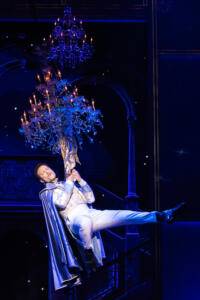
PC: Matthew Murphy
And in fact throughout the piece come moments of true bliss– the stepsisters (Amy Hillner Larsen and Tess Soltau) surrounded by breakdancing mice and barking chores in the form of “Work Bitch”, the prince (Justin Guarini) swinging on a chandelier to “Make Me Ooh”, Jennifer Simard eerily screeching through “Toxic” (when will this brilliantly sharp actress get a role worthy of her talents that doesn’t rely on fatphobia??). The princess ensemble dances their hearts out especially Justice Moore, Liv Battista, and Selene Haro as Red Riding Hood, Belle, and Gretel respectively. Husband and wife director/choreography team Keone and Mari Madrid rightfully milk the songs for all they’re worth, often with false endings and long dance breaks.
And if the show let itself be just a silly, good time, Britney Spears princess dance party, I might not mind it so much. Instead it aims to take on the patriarchy by offering the most dated, vague, and insultingly hollow iteration of feminism I’ve seen in a long time (no small feat in the girlboss-scape we currently find ourselves in). The most brazen example is when the O.F.G. (Original Fairy Godmother, a serviceable Brooke Dillman) teaches Cinderella about feminism through none other than Betty Friedan’s The Feminine Mystique.
I cannot for the life of me understand what went into this decision. The Feminine Mystique is racist, classist and homophobic. Betty Friedan was considered out of touch even by her contemporaries and that was in the 1960s. In the introduction to her 1984 book From Margin to Center bell hooks called it “a case study of narcissism, insensitivity, sentimentality, and self-indulgence, which reaches its peak when Friedan, in a chapter titled “Progressive Dehumanization,” makes a comparison between the psychological effects of isolation on white housewives and the impact of confinement on the self-concept of prisoners in Nazi concentration camps.” What is a musical in the year 2023 doing not only uncritically valorizing her contribution to feminism, but building its plot around her? They are selling The Feminist Mystique as merch at the Marquis Theater! It is as if book writer Jon Hartmere clicked on the wikipedia article for feminism and stopped reading after the first paragraph! The only other examples of feminists the show even alludes to are a nameless suffragette and Oprah Winfrey. In this fairytale world feminism has been reduced to a simple 1, 2, 3 of Betty Freidan, voting, and Oprah.
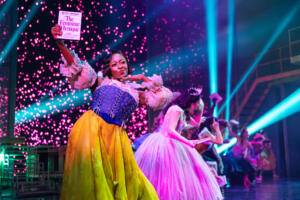
PC: Matthew Murphy
And then in a truly baffling moment at the end, the O.F.G. reveals with a wink that she is Betty Friedan and is currently residing in Flatbush??? How in the year of 2023 is our idea of a fairy godmother Flatbush Betty Friedan??
Having coined the phrase Lavender Menace (which has since been reclaimed) to warn of the threat lesbians posed to the women’s movement, Friedan would likely be horrified to see her name used in a story that allows a gay couple to be a part of the feminist movement. On the other hand, she may be heartened to know it’s between two utterly irrelevant side characters whose entire personalities can be boiled down to one single joke each. Prince Erudite is celibate (though actually just gay. Being closeted is hilarious.) and Clumsy is… well you know. Even the otherwise enthusiastic audience never seemed to get on board with the running bit of crashing noises every time Clumsy left the stage, just one example of the groan worthy humor throughout.

PC: Matthew Murphy
Quite by accident the show nearly approaches a critique of white feminism by making (white) Cinderella’s problem being vaguely bored with her life and (Black) Snow White’s being chased by a murderous huntsman sent to cut out her lungs and liver. Much like its guiding text The Feminine Mystique, Once Upon a One More Time centers the ennui of its white heroine while neglecting the material conditions of the more marginalized characters. But other than a throw away joke about not touching Rapunzel’s hair, Hartmere’s book doesn’t consider race at all. One has to assume that if it did there wouldn’t be so many jokes about Snow White not being able to read or write.
Nothing about the show is new, but who is really expecting it to be? It’s not even new to have Britney songs in shows. There are two other shows with Britney songs in them currently playing on Broadway. What upsets me most isn’t its lack of challenging ideas, but it’s insistence that it has something radical to offer.
If the show’s cringeworthy tagline “well behaved princesses rarely make history” is true, then that’s also true of well behaved shows. Aside from some embarrassingly ignorant slips into racism, ableism, and fatphobia, this show is perfectly well behaved. The men are easily hateable cartoons of misogyny calling the princesses shrill and hysterical. The women are perfect victims, righteous and beautiful. Everyone stays in the roles the American media has so often assigned to them: white protagonist, Black best friend, evil stepsisters who are fatter (and thus less worthy) than the uniformly skinny princesses, a general wash of diversity without ever getting to hear the stories of the people of color.
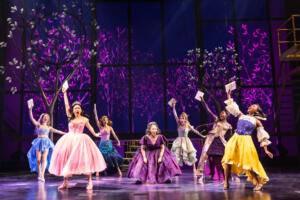
PC: Matthew Murphy
There is much hand wringing over Ariel giving up her (speaking) voice without acknowledging that she actually communicates fairly effectively through gesturing. (Not through American or any other Sign Language mind you. The inclusion of ASL would utterly undermine the premise that anything other than vocal speech is a miserable, tragic fate). There are gay characters, but they’re sidelined from the main movement with only physical proximity to bind their struggles to the larger feminist goal. Which is what exactly? At the beginning of the show there’s a throwaway joke about the prince getting paid but not Cinderella, but it is never revisited. In the second act the princesses join a “Million Princess March” and display their newly liberated status not with demands, but rather a costume change (Loren Elstein’s traditional knockoff Disney princess costumes are replaced by more sparkly more “modern” knockoff Disney princess costumes). Feminism, according to Once Upon a One More Time, is merely a matter of aesthetics.
The show also falls prey to a common problem in which despite it being about the women, the stand out character is really the man. Justin Guarini gets the best songs (“Circus”, “Oops I did it Again”, “Make me Ooh”) and oozes charisma. In making the women characters crusaders for justice they don’t get to just be silly like Guarini can, but by never defining what justice would actually mean for them they don’t get to be deep, inspirational, or thought provoking either. (One could argue a similar phenomenon played out in Greta Gerwig’s Barbie in which Ryan Reynolds’ Ken gets a delightfully campy 5 minute musical number while Margot Robbie’s Barbie discovers crying).
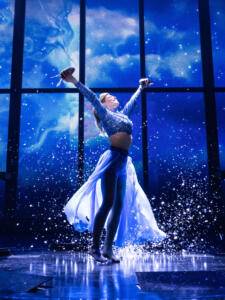
PC: Matthew Murphy
Maybe I’m taking all of this too seriously, but the show itself insists that our stories are important. As O.F.G. (Flatbush Betty Friedan) explains to Cinderella “the stories you’ve been reading, and living… they can be… limiting. And quite frankly deeply problematic. Towards certain people. (…) They just can give you a very warped view of the world. The real world. Out there, beyond Story’s End.” This story is no different. I’m not saying the Britney Spears jukebox musical should have been a dense dispatch on Black Feminist Thought, but they didn’t even bother to get a female to write this so-called modern feminist classic. They didn’t even bother to have a female creative consultant.
This brings me back to my original question. Sure using Britney Spears music seems on paper like a safe money making bet, but is that actually what people want? We are living in the age of adaptation but many of these attempts at musicalizing familiar intellectual properties have met similarly disappointing fates. Bad Cinderella (another fairytale adaptation) closed after 85 performances. Movie to stage attempts Almost Famous and Mrs. Doubtfire closed after 77 and 75 respectively. If we think back to the times a musical has truly broken through it has often brought with it something new and exciting. Hamilton integrated classical musical theater with hip-hop, Hadestown brought a more folky, indie sound, even Rent was revolutionary at the time for its contemporary styling. Why then are we stuck in play-it-safe purgatory? Playing it safe isn’t even paying off!
I don’t know for sure that taking bold artistic risks will pay off, all I know is we’re more likely to create theater that meets the needs of the moment by trying than by sloughing off ever weakening copies of that which already exists. As both an artistic and commercial failure, Once Upon a One More Time should be a warning, but also an inspiration. What would we create if instead of doing the same thing one more time, next time we tried something different?
This post was written by the author in their personal capacity.The opinions expressed in this article are the author’s own and do not reflect the view of The Theatre Times, their staff or collaborators.
This post was written by Morgan Skolnik.
The views expressed here belong to the author and do not necessarily reflect our views and opinions.

